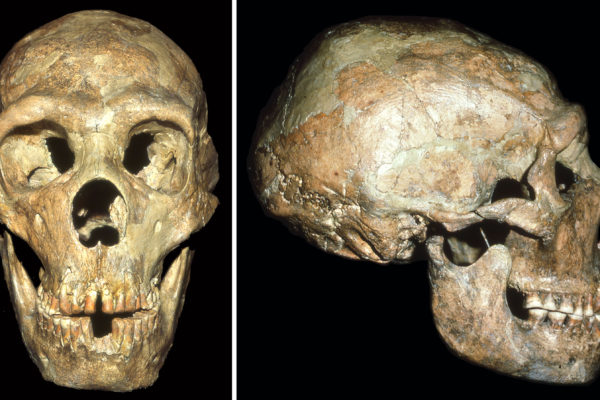Older Neandertal survived with a little help from his friends
A young Neandertal left deaf and partially paralyzed by a crippling blow to the head about 40,000 years ago must have relied on the help of others to avoid prey and survive well into his 40s, suggests a new analysis published Oct. 20 in the online journal PLoS ONE.
Studies affirm relationship between early humans, Neandertals
Joe Angeles/WUSTL PhotoErik Trinkaus, WUSTL professor of anthropology in Arts & Sciences, holding a Neandertal skull, says the evidence is very convincing that Neandertals and early humans mixed.For nearly a century, anthropologists have been debating the relationship of Neandertals to modern humans. Central to the debate is whether Neandertals contributed directly or indirectly to the ancestry of the early modern humans that succeeded them. As this discussion has intensified in the past decades, it has become the central research focus of Erik Trinkaus, Ph.D., professor of anthropology at Washington University in St. Louis. Trinkaus has examined the earliest modern humans in Europe, including specimens in Romania, Czech Republic and France. Those specimens, in Trinkaus’ opinion, have shown obvious Neandertal ancestry.
Redating of the latest Neandertals in Europe
TrinkausTwo Neandertal fossils excavated from Vindija Cave in Croatia in 1998, believed to be the last surviving Neandertals, may be 3,000-4,000 years older than originally thought. An international team of researchers, including Erik Trinkaus, Ph.D., the Mary Tileston Hemenway Professor of anthropology in Arts & Sciences, has redated the two Neandertals from Vindija Cave, the results of which have been published in the Jan. 2-6 early edition of the journal Proceedings of the National Academy of Sciences (PNAS).
Oldest cranial, dental and postcranial fossils of early Modern European humans confirmed
Where have you gone, Joe Neandertal?The human fossil evidence from the Mladec Caves in Moravia, Czech Republic, excavated more than 100 years ago, has been proven for the first time, through modern radiocarbon dating, to be the oldest cranial, dental and postcranial assemblage of early modern humans in Europe. A team of researchers from the Natural History Museum in Vienna, from the University of Vienna in Austria and from Washington University in St. Louis recently conducted the first successful direct dating of the material.
Earliest modern humans in Europe found
Erik TrinkausA human jawbone (left), dated to between 34,000 and 36,000 years ago, along with a facial skeleton (center) and a temporal bone (right).A research team co-directed by Erik Trinkaus, Ph.D., professor of anthropology at Washington University in St. Louis, has dated a human jawbone from a Romanian bear hibernation cave to between 34,000 and 36,000 years ago. That makes it the earliest known modern human fossil in Europe. Other human bones from the same cave — a temporal bone, a facial skeleton and a partial braincase — are still undergoing analysis, but are likely to be the same age. The jawbone was found in February 2002 in Pestera cu Oase — the “Cave with Bones” — located in the southwestern Carpathian Mountains. The other bones were found in June 2003.

